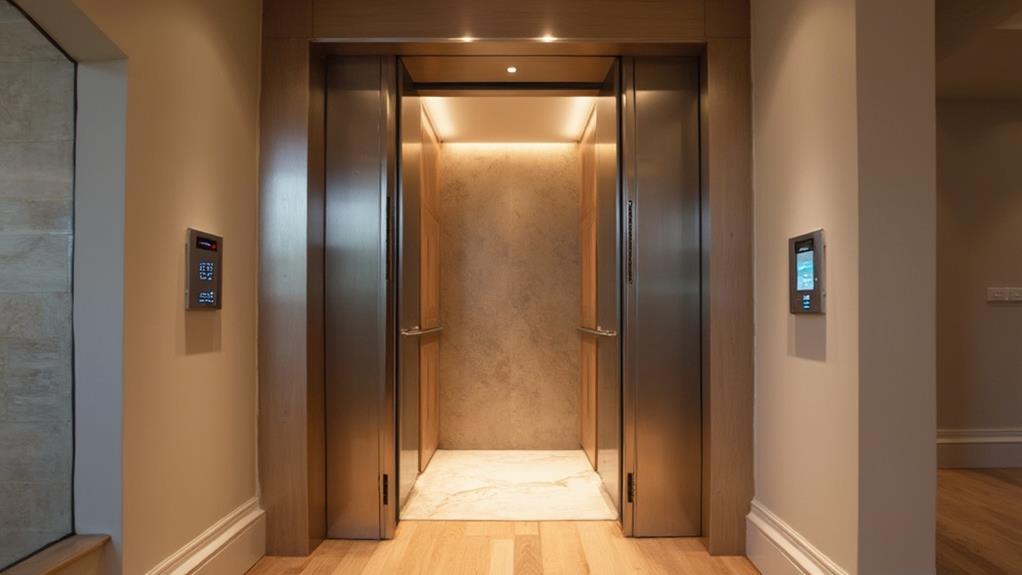Renovating for better home security involves a multi-faceted approach combining smart technology and strategic design. Start by assessing your home's vulnerabilities, focusing on entry points and valuable assets. Implement smart locks and advanced surveillance systems for comprehensive monitoring and access control. Enhance lighting both indoors and outdoors to deter intruders and improve visibility. Consider security-minded landscaping techniques, such as using thorny shrubs and gravel pathways. Upgrade windows and doors with reinforced materials and smart sensors. Integrate home automation systems for coordinated security responses. By following these design and technology tips, you'll create a safer, more secure living environment.
Assessing Your Home's Security Needs
Vulnerability is the first consideration when assessing your home's security needs. Evaluate potential entry points, including doors, windows, and basement access. Analyze the surrounding landscape for hiding spots or easy climb-up areas. Consider your neighborhood's crime rate and specific security concerns.
Conduct a thorough inspection of existing security measures. Check the condition of locks, doorframes, and window latches. Assess outdoor lighting, particularly around entry points and dark corners. Evaluate your current alarm system, if any, and determine if updates are necessary.
Identify valuable assets within your home that require additional protection. This may include safes, electronics, or important documents. Consider creating a secure room or area for these items.
Assess your family's lifestyle and habits. Do you travel frequently? Work late hours? Have children home alone after school? These factors influence your security needs.
Smart Locks and Access Control
At the forefront of modern home security technology, smart locks and access control systems offer homeowners enhanced convenience and protection. These devices replace traditional key-based locks with digital alternatives that can be operated via smartphone apps, keypads, or biometric scanners. Smart locks allow users to grant temporary access to visitors, monitor entry and exit times, and receive real-time notifications of door activity.
When selecting a smart lock, consider factors such as compatibility with existing door hardware, integration with other smart home devices, and backup entry methods in case of power outages or connectivity issues. Popular features include auto-locking, geofencing, and voice assistant compatibility.
Access control systems extend beyond individual doors, encompassing comprehensive solutions for managing entry points throughout the property. These may include video doorbells, intercoms, and centralized control panels. Advanced systems can integrate with security cameras, alarm systems, and home automation platforms for a cohesive security ecosystem.
To ensure optimal performance and security, professional installation is recommended for smart locks and access control systems. Regular software updates and periodic security audits help maintain the integrity of these digital security measures.
Advanced Surveillance Systems
Modern home security increasingly relies on advanced surveillance systems to provide comprehensive monitoring and deterrence. These systems typically include high-resolution cameras, motion sensors, and smart analytics software.
Outdoor cameras with night vision capabilities can monitor entry points and perimeters, while indoor cameras offer coverage of key areas within the home. Many systems now incorporate artificial intelligence to differentiate between normal activity and potential threats, reducing false alarms.
Network video recorders (NVRs) allow homeowners to store and review footage, often accessible remotely via smartphone apps. Some advanced systems integrate with other smart home devices, enabling automated responses such as turning on lights or sounding alarms when suspicious activity is detected.
Two-way audio features in certain cameras allow for communication with visitors or intruders.
When planning a surveillance system, consider camera placement, video quality, storage capacity, and connectivity options. Ensure compliance with local privacy laws, especially for cameras facing public areas. Professional installation may be advisable for complex setups, though many modern systems are designed for DIY installation.
Regular maintenance and software updates are crucial for optimal performance and security of these advanced surveillance systems.
Lighting for Safety and Deterrence
Effective lighting plays a dual role in home security, enhancing safety for residents while deterring potential intruders. Strategic placement of exterior lights illuminates entry points, walkways, and potential hiding spots, making it difficult for unauthorized individuals to approach undetected. Motion-activated floodlights are particularly effective, startling trespassers and drawing attention to suspicious activity.
For interior spaces, smart lighting systems offer programmable schedules and remote control capabilities. These features create the illusion of occupancy when homeowners are away, discouraging break-ins. Layered lighting techniques, combining ambient, task, and accent lighting, eliminate dark corners and improve overall visibility within the home.
When selecting fixtures, opt for energy-efficient LED bulbs with high lumens output. Position lights to minimize glare and shadows, ensuring clear visibility without compromising comfort. Consider installing timers or light sensors to automate exterior lighting, ensuring consistent illumination from dusk to dawn. For added security, integrate lighting with other smart home systems, allowing for coordinated responses to potential threats. Properly designed lighting not only enhances the aesthetic appeal of a property but also serves as a crucial component in a comprehensive home security strategy.
Landscaping With Security in Mind
Thoughtful landscaping design can significantly enhance a property's security while maintaining its aesthetic appeal. Strategic placement of plants and hardscaping elements can deter intruders and create natural barriers without compromising the beauty of your outdoor space.
Consider using thorny or prickly shrubs beneath windows and along property boundaries to discourage unauthorized access. Plants like holly, roses, and barberry serve this purpose effectively. However, ensure that vegetation near entry points and windows is kept trimmed to eliminate potential hiding spots for intruders.
Incorporate gravel or loose stone pathways around the perimeter of your home. These materials create noise when walked upon, alerting residents to potential threats. Additionally, use low-growing groundcover plants in open areas to maintain clear sightlines from windows and doors.
Proper outdoor lighting integrated with landscaping can further enhance security. Install motion-activated lights in garden areas and along pathways. Use uplighting on trees and architectural features to eliminate dark corners where intruders might hide.
Secure Windows and Doors
Fortifying windows and doors stands as a critical step in enhancing home security. These entry points are often the most vulnerable areas of a home, making them prime targets for intruders. To bolster security, homeowners should consider installing high-quality deadbolts on all exterior doors, ensuring they are properly fitted and reinforced with strike plates.
For sliding doors, adding security bars or pins can prevent forced entry. Window security can be improved by installing laminated or tempered glass, which is more resistant to breaking. Adding window locks, security film, or impact-resistant shutters further enhances protection. For ground-floor windows, consider planting thorny bushes beneath them to deter potential intruders.
Smart locks and security systems can provide additional layers of protection. These technologies allow for remote monitoring and control of entry points, often integrating with smartphones for convenience. Motion-activated lighting around windows and doors can also act as a deterrent.
Regular maintenance of doors and windows is crucial. Ensure frames are sturdy, hinges are secure, and there are no gaps that could be exploited. By implementing these measures, homeowners can significantly reduce the risk of unauthorized entry and improve overall home security.
Home Automation for Safety
Home automation systems have revolutionized residential security, offering homeowners unprecedented control and monitoring capabilities. These systems integrate various smart devices and sensors to enhance home safety and provide real-time alerts.
Key components include smart door locks, which can be remotely controlled and programmed with unique access codes for family members and trusted visitors. Video doorbells allow homeowners to see and communicate with anyone at their doorstep, even when away from home.
Motion sensors and smart cameras can detect and record suspicious activities, sending instant notifications to homeowners' smartphones. Automated lighting systems can be programmed to simulate occupancy when the house is vacant, deterring potential intruders.
Smart smoke and carbon monoxide detectors provide early warnings and can be integrated with HVAC systems to shut off in case of a fire.
Voice-controlled assistants like Amazon Alexa or Google Home can be used to quickly activate emergency protocols or contact authorities. Many home automation systems also offer professional monitoring services for an additional layer of security.
When implementing these technologies, it's crucial to prioritize cybersecurity measures to protect against potential hacking attempts and ensure the system's integrity.
Integrating Security With Interior Design
While technological advancements have significantly enhanced home security, integrating these features seamlessly into interior design is a key consideration for homeowners. The challenge lies in incorporating security elements without compromising aesthetic appeal or creating an overly fortified appearance.
One approach is to opt for hidden or camouflaged security devices. For instance, security cameras can be disguised as decorative objects or integrated into light fixtures. Smart locks can be chosen to match door hardware styles, maintaining a cohesive look. Motion sensors can be incorporated into crown molding or baseboards, becoming virtually invisible.
Window treatments offer another opportunity for discreet security integration. Reinforced blinds or shades can provide both privacy and protection against break-ins. Similarly, impact-resistant windows can be selected in styles that complement the home's architecture.
For visible security elements, such as outdoor cameras or alarm system panels, consider coordinating their colors and finishes with the overall design scheme. Custom enclosures or decorative covers can help blend these devices with surrounding decor.
Frequently Asked Questions
How Can I Secure My Home During Extended Travel Periods?
To secure your home during extended travel, install a smart security system with cameras and remote monitoring. Use automated lighting, timers for indoor lights, and ask a trusted neighbor to check on the property regularly. Consider a professional house-sitting service.
What Are the Best Security Measures for Homes in High-Crime Areas?
For homes in high-crime areas, implement multiple layers of security: Install robust door locks, security cameras, and alarm systems. Use motion-activated lighting, reinforce windows, and consider security film. Join neighborhood watch programs and maintain good relationships with neighbors.
How Can I Protect My Home From Tech-Savvy Intruders?
To protect your home from tech-savvy intruders, implement robust cybersecurity measures for smart devices, use encrypted Wi-Fi networks, regularly update software, enable two-factor authentication, and invest in advanced security systems with tamper-proof features and remote monitoring capabilities.
Are There Pet-Friendly Home Security Options Available?
Like a watchful guard dog, modern security systems offer pet-friendly options. Motion sensors can be adjusted to ignore pet movements, while cameras allow remote monitoring. Smart doorbells and pet doors with microchip readers provide additional safety for furry family members.
What Security Precautions Should I Take When Hosting Short-Term Rentals?
When hosting short-term rentals, implement keyless entry systems, install security cameras in common areas, use smart locks for individual rooms, conduct thorough guest screenings, secure valuables in a safe, and maintain clear communication with neighbors regarding guest activity.
Conclusion
In conclusion, fortifying one's domestic sanctuary necessitates a multifaceted approach. By interweaving cutting-edge technology with thoughtful design elements, homeowners can create a haven that balances aesthetics with protection. From intelligent entry systems to strategically illuminated landscapes, each component plays a crucial role in deterring unwanted visitors. When security measures harmoniously blend with interior decor, residents can enjoy peace of mind without sacrificing style. Ultimately, a well-secured home becomes an impenetrable fortress, safeguarding both loved ones and cherished possessions.

